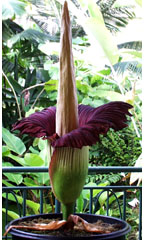 |
| June 25, 1998 Amorphophallus titanum fully open in the conservatory Height: 60 inches Diameter: 30 inches |
Amorphophallus titanum History & Statistics
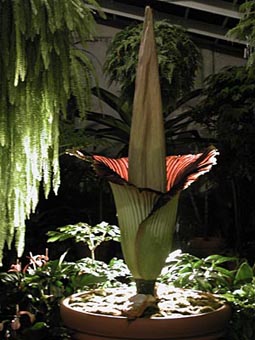 |
| May 15, 2001
Amorphophallus titanum nearly open in the conservatory. Height: 80.25 inches Diameter: 45 inches |
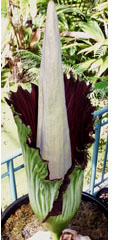 |
| June 24, 1998 Strong odor |
 |
| June 25, 1998 |

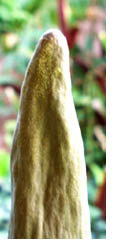
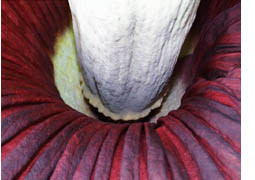 |
| June 24, 1998 Flowers hidden a base of spadix |
History
When it was discovered in the rainforest of central Sumatra in western Indonesia, by the Italian botanist and explorer Dr. Odoardo Beccari in 1878, the stories caused quite a sensation and disbelief among European botanists. Not until the first specimen flowered in cultivation at Royal Botanic Gardens, Kew, England in 1889 did the world take notice. During the Victorian era plant hunting was at its height and unusual specimens were enjoyed by a discerning and curious audience. It was also an era where governesses protected young women from such an indecent sight. Whenever the Amorphophallus titanum, which grows only in western Sumatra, has flowered in cultivation it has attracted an enormous amount of attention. The 1998 bloom attracted more than 5,500 visitors to Fairchild Tropical Botanic Garden and worldwide media attention as the first documented bloom of this species in the United States since 1939. A 1996 bloom of this species attracted thousands of people to Royal Botanic Gardens, Kew, as did a 1970 two-day flowering in Java which attracted 34,000 viewers. It was introduced to the United States in 1937 when the New York Botanic Garden and the daily press kept the public informed of the progress of the gigantic bloom grown from an imported tuber. The spectacular event so impressed people that when a second specimen flowered (from another imported tuber) two years later it was designated as the official flower of the Bronx, symbolic of the largest and fastest growing borough of the City of New York. The discovery of this species must rank as one of the greatest highlights of natural history exploration.
Statistics
The sight, growth and odor of this rare botanical wonder are unbelievable. A mature underground corm (tuber) produces a huge aroid bloom (inflorescence) which is usually taller than a man. When it first emerges the spadix is completely enveloped in the spathe and bracts, but as it develops the growth rate of the spadix accelerates rapidly. It is ranked as the largest unbranched inflorescence in the world, which is produced by the largest tuber. A single huge leaf will emerge sometime after the flower resembling a sapling tree. A mature leaf is patterned with irregular pale green blotches and at the apex divides into an umbrella of leaflets up to 49 feet in circumference.
The A. titanum is difficult to cultivate - not because, as was also once rumored, it eats its grower - but because it is prone to rotting, does not reliably increase in size and fails to produce seeds or offsets as easily as other species of Amorphophallus. The plants rarely set seeds because the female flowers open first and by the time the male florets are producing pollen they are no longer receptive. Each plant contains both flowers and florets. Even in the wild it is difficult because there must be an another similarly timed pollen producing inflorescence. In addition, flowering can take at any time of the year so chances are stacked against pollination. There was once a rumor that this monstrous inflorescence is pollinated by elephants. Instead pollination is believed to be performed by large carrion beetles lured by the powerful odor of decaying flesh. This overpowering stench is released in waves when the flowers are ready for pollination. Its Indonesian name bunga bangkai means corpse flower.
More on Amorphophallus titanum:
Aroideana, Volume 17, 1994 and Aroideana, Volume 19, 1996, illustrated annual journals by the International Aroid Society, PO Box 43-1853, South Miami, FL 33143 USA or call 305/667-1651, ext. 3391.
Photos: Craig M. Allen
DHTML JavaScript Menu By Milonic.com
Copyright © 2007 Virtual Herbarium - All rights reserved
11935 Old Cutler Road, Coral Gables, FL 33156-4299 USA
Phone: 305-667-1651 • Fax 305-665-8032
